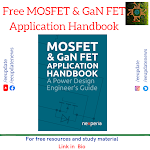Power Electronics Daniel W. Hart
Title: Power Electronics
Author: Daniel W. Hart
Publisher: McGraw-Hill Education
Audience: Undergraduate engineering students, especially in Electrical and Electronics streams
🔍 Introduction
In the world of power electronics education, clarity is everything. Daniel W. Hart's "Power Electronics" delivers just that—a well-balanced, conceptually strong, and application-friendly introduction to power electronics. Designed primarily for undergraduates, this book bridges the gap between basic circuit analysis and real-world power conversion systems.
If you're a student trying to wrap your head around choppers, inverters, and switching behavior of modern devices, this book is a gem.
📚 Overview and Teaching Style
Daniel Hart takes a circuit-centric approach—building on the reader’s knowledge of basic electronics and circuit theory to develop power electronics circuits and systems. The book keeps mathematics and theory at an accessible level, focusing more on engineering insight than deep semiconductor physics.
The pedagogy is modern and well-structured:
-
🔧 Step-by-step explanations
-
💡 Plenty of conceptual figures and simulation waveforms
-
🧮 Example-rich chapters with end-of-chapter problems
-
🔄 Simulation results from PSPICE and MATLAB integrated into the discussion
🧩 Chapter-Wise Breakdown (Simplified)
| Section | Topics Covered |
|---|---|
| 1. Introduction | Overview of power electronics applications and system blocks |
| 2. Power Semiconductor Devices | Diode, BJT, MOSFET, IGBT – switching behavior, ratings |
| 3. Diode Circuits | Single and three-phase rectifiers, performance metrics |
| 4. Thyristor Circuits | SCR, phase control, triggering methods |
| 5. DC-DC Converters | Buck, boost, buck-boost, continuous/discontinuous modes |
| 6. DC-AC Inverters | Single-phase and three-phase inverters, harmonic analysis |
| 7. AC Voltage Controllers & Cycloconverters | Principles and typical waveforms |
| 8. Power Supplies | Linear vs switching regulators, SMPS, PFC basics |
| 9. Motor Drives | Basics of motor control, interfacing with converters |
| Appendices | Simulation techniques, component data sheets, software tools |
✅ Strengths of the Book
-
Clean and Crisp Explanations: Very readable, especially for beginners.
-
Circuit-Focused Pedagogy: Teaches power electronics like a continuation of basic electronics—great for retention.
-
Simulation Integration: Incorporates PSPICE and MATLAB results directly into the learning process.
-
Real-World Applications: The examples include motor drives, battery chargers, and SMPS design.
-
Visual Learning: Lots of waveforms, timing diagrams, and illustrations that aid conceptual clarity.
⚠️ Limitations
-
Device Physics is Basic: This book is not meant for those wanting to dive deep into semiconductor-level modeling.
-
PWM Techniques are Introductory: Advanced control schemes like SVPWM or predictive control are not covered.
-
Application Depth is Moderate: Focus is on understanding—not deeply optimizing—converter performance.
-
Not Graduate-Level: It lacks the control theory and rigor needed for M.Tech or research-level work.
🎓 Who Should Read This Book?
| User Type | Usefulness |
|---|---|
| Undergraduate Students | ✅ Excellent first textbook |
| Competitive Exam Prep (GATE/PSU) | ✅ Good for concept revision |
| Design Engineers (Beginners) | ✅ Solid intro, especially if circuit-oriented |
| Graduate Students | ❌ Too basic—look for Mohan, Rashid, or Erickson |
| Researchers | ❌ Not enough modeling or mathematical depth |
🆚 Comparison with Other Popular Texts
| Feature | Hart | Rashid | Bimbhra | Mohan |
|---|---|---|---|---|
| Language | Modern & clean | Student-friendly | Classic & traditional | Analytical |
| Focus | Circuit analysis | Balanced approach | Syllabus-driven | Control & analysis |
| Level | Undergraduate | UG/PG | Beginner | Advanced UG/PG |
| Applications | Covered, but light | Wide | Basic | Strong on motor drives |
| Device Physics | Basic | Moderate | Basic | Moderate |
🛠️ Recommended Study Strategy
-
Start with the device chapters to get comfortable with switching behavior
-
Use the converter chapters (DC-DC, DC-AC, AC-DC) to develop problem-solving skills
-
Practice waveform sketching for understanding conduction intervals
-
Simulate circuits alongside reading using PSPICE or LTspice
-
Use end-of-chapter problems to test and reinforce understanding
📌 Conclusion
Daniel W. Hart’s Power Electronics is one of the best starting points for anyone beginning their journey into power electronics. It’s especially suited for students looking for clarity, clean explanations, and a practical understanding of circuits.
If you're overwhelmed by books like Rashid or Mohan, Hart offers a refreshing, approachable alternative that teaches you how converters work from a circuit perspective rather than diving into complex control theory or device physics.
In short, it’s ideal for classroom teaching, self-study, or a semester-long course in power electronics.
























No comments